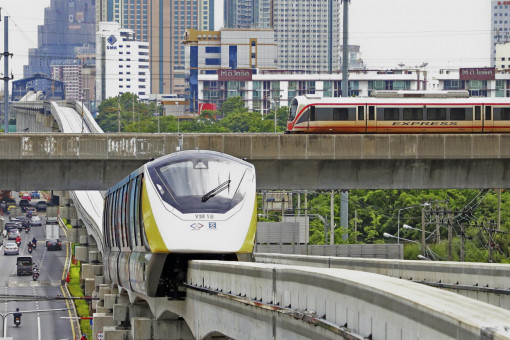Undercarriage boost after latest mishap

Wuhu: The reputation of Bangkok’s newly opened monorail lines has taken a blow, after an incident at the start of the year saw a guide wheel of a Yellow Line train come off, damaging a car on the road below.
Right after the incident, Eastern Bangkok Monorail (EBM), which holds the concession to run services along the Yellow Line, said the guide wheel came off due to a faulty bearing.
However, many people found the answer insufficient — after all, how could such a mishap take place on a newly launched electric train line that cost the government billions of baht to build and is only a few months old?
This is not the first accident to affect the monorails. Earlier, a long section of the Pink Line’s conductor rail also fell, causing similar damage.
The Mass Rapid Transit Authority of Thailand (MRTA) has improved safety standards and procedures along the Yellow and Pink Lines to regain public confidence in the city’s monorails.
As part of the effort, MRTA took 40 journalists and state sector officials to a plant run by CRRC Puzhen Alstom Transportation Systems Limited (PATS), which produces the trains used along Bangkok’s monorail lines, in Wuhu, a city in China’s Anhui province last month.
During the trip, the manufacturer explained what improvements were implemented to prevent similar problems. A PATS representative said the guide wheel came off as the bearing holding it in place failed due to excess friction.
The lubricant used in the bearing had changed properties under high temperatures, reducing its lubricating properties.
No similar failures had been reported in other lines which run the Innovia Monorail 300 units used in Bangkok, such as in Brazil, Egypt and China, he said.
“This incident is unique to Bangkok, but we’re committed to ensuring it doesn’t happen again,” said the representative.
PATS moved to reinforce the undercarriage of the trains to prevent the incident from re-occurring.
The upgrades include improved support at the axle, six additional bolts to prevent wheel displacement, and new sensors to monitor temperature and humidity.
Should a sensor detect abnormal levels of temperature or humidity, it will signal the control centre to promptly stop the affected train and call it to return to a maintenance station within the hour, he said.
Two trains have been upgraded with reinforced undercarriages, one on the Yellow Line and the other on the Pink Line. The trains are currently undergoing safety testing, which is scheduled to run until January.
MRTA’s director of system operations, Nuttapat Ounhakongka, said if the tests prove successful, the upgrades will be applied to all 72 monorail trains in service starting in 2025. The process will begin in February and is expected to be completed by the end of the year.
Mr Nuttapat said EBM had been instructed to review its maintenance schedule after the incident. Every train put on service is inspected every other day instead of the normal bi-monthly inspection.
He said the EBM is also considering installing cameras along rail switches to detect any abnormal wheel movements.
Mr Nuttapat also assured that PATS and EBM would shoulder the cost of upgrading the trains.
MRTA deputy governor Sarot T. Suwan said about 46,600 passengers used the Yellow Line between Oct 1 and 21, while the Pink Line reported about 56,785 passengers per day in the same period.
The two lines link downtown Bangkok with the city’s eastern and northern suburbs, an integral part of Bangkok’s long-term transport strategy.
The number of passengers on both lines is expected to gradually increase over the next two years, at a rate of about 2.5% per year.

